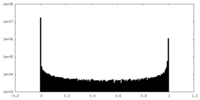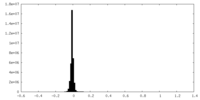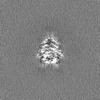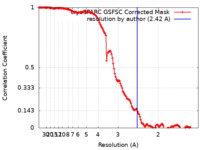+ データを開く
データを開く
- 基本情報
基本情報
| 登録情報 |  | |||||||||
|---|---|---|---|---|---|---|---|---|---|---|
| タイトル | Cryo-EM structure of 1-deoxy-D-xylulose 5-phosphate synthase (DXPS) from Plasmodium falciparum | |||||||||
 マップデータ マップデータ | ||||||||||
 試料 試料 |
| |||||||||
 キーワード キーワード | 1-deoxy-D-xylulose 5-phosphate synthase / thiamin di-phosphate complex / transketolase / TRANSFERASE | |||||||||
| 機能・相同性 |  機能・相同性情報 機能・相同性情報1-deoxy-D-xylulose-5-phosphate synthase / : / 1-deoxy-D-xylulose-5-phosphate synthase activity / thiamine biosynthetic process / terpenoid biosynthetic process / metal ion binding / membrane 類似検索 - 分子機能 | |||||||||
| 生物種 |  | |||||||||
| 手法 | 単粒子再構成法 / クライオ電子顕微鏡法 / 解像度: 2.42 Å | |||||||||
 データ登録者 データ登録者 | Gawriljuk VO / Godoy AS / Oerlemans R / Groves MR | |||||||||
| 資金援助 | European Union,  英国, 2件 英国, 2件
| |||||||||
 引用 引用 |  ジャーナル: Nat Commun / 年: 2024 ジャーナル: Nat Commun / 年: 2024タイトル: Cryo-EM structure of 1-deoxy-D-xylulose 5-phosphate synthase DXPS from Plasmodium falciparum reveals a distinct N-terminal domain. 著者: Victor O Gawriljuk / Andre S Godoy / Rick Oerlemans / Luise A T Welker / Anna K H Hirsch / Matthew R Groves /    要旨: Plasmodium falciparum is the main causative agent of malaria, a deadly disease that mainly affects children under five years old. Artemisinin-based combination therapies have been pivotal in ...Plasmodium falciparum is the main causative agent of malaria, a deadly disease that mainly affects children under five years old. Artemisinin-based combination therapies have been pivotal in controlling the disease, but resistance has arisen in various regions, increasing the risk of treatment failure. The non-mevalonate pathway is essential for the isoprenoid synthesis in Plasmodium and provides several under-explored targets to be used in the discovery of new antimalarials. 1-deoxy-D-xylulose-5-phosphate synthase (DXPS) is the first and rate-limiting enzyme of the pathway. Despite its importance, there are no structures available for any Plasmodium spp., due to the complex sequence which contains large regions of high disorder, making crystallisation a difficult task. In this manuscript, we use cryo-electron microscopy to solve the P. falciparum DXPS structure at a final resolution of 2.42 Å. Overall, the structure resembles other DXPS enzymes but includes a distinct N-terminal domain exclusive to the Plasmodium genus. Mutational studies show that destabilization of the cap domain interface negatively impacts protein stability and activity. Additionally, a density for the co-factor thiamine diphosphate is found in the active site. Our work highlights the potential of cryo-EM to obtain structures of P. falciparum proteins that are unfeasible by means of crystallography. | |||||||||
| 履歴 |
|
- 構造の表示
構造の表示
| 添付画像 |
|---|
- ダウンロードとリンク
ダウンロードとリンク
-EMDBアーカイブ
| マップデータ |  emd_18842.map.gz emd_18842.map.gz | 202.5 MB |  EMDBマップデータ形式 EMDBマップデータ形式 | |
|---|---|---|---|---|
| ヘッダ (付随情報) |  emd-18842-v30.xml emd-18842-v30.xml emd-18842.xml emd-18842.xml | 18.6 KB 18.6 KB | 表示 表示 |  EMDBヘッダ EMDBヘッダ |
| FSC (解像度算出) |  emd_18842_fsc.xml emd_18842_fsc.xml | 13.2 KB | 表示 |  FSCデータファイル FSCデータファイル |
| 画像 |  emd_18842.png emd_18842.png | 81.2 KB | ||
| マスクデータ |  emd_18842_msk_1.map emd_18842_msk_1.map | 244.1 MB |  マスクマップ マスクマップ | |
| Filedesc metadata |  emd-18842.cif.gz emd-18842.cif.gz | 6.3 KB | ||
| その他 |  emd_18842_additional_1.map.gz emd_18842_additional_1.map.gz emd_18842_half_map_1.map.gz emd_18842_half_map_1.map.gz emd_18842_half_map_2.map.gz emd_18842_half_map_2.map.gz | 121.7 MB 226.5 MB 226.5 MB | ||
| アーカイブディレクトリ |  http://ftp.pdbj.org/pub/emdb/structures/EMD-18842 http://ftp.pdbj.org/pub/emdb/structures/EMD-18842 ftp://ftp.pdbj.org/pub/emdb/structures/EMD-18842 ftp://ftp.pdbj.org/pub/emdb/structures/EMD-18842 | HTTPS FTP |
-検証レポート
| 文書・要旨 |  emd_18842_validation.pdf.gz emd_18842_validation.pdf.gz | 930.5 KB | 表示 |  EMDB検証レポート EMDB検証レポート |
|---|---|---|---|---|
| 文書・詳細版 |  emd_18842_full_validation.pdf.gz emd_18842_full_validation.pdf.gz | 930.1 KB | 表示 | |
| XML形式データ |  emd_18842_validation.xml.gz emd_18842_validation.xml.gz | 22.1 KB | 表示 | |
| CIF形式データ |  emd_18842_validation.cif.gz emd_18842_validation.cif.gz | 28.7 KB | 表示 | |
| アーカイブディレクトリ |  https://ftp.pdbj.org/pub/emdb/validation_reports/EMD-18842 https://ftp.pdbj.org/pub/emdb/validation_reports/EMD-18842 ftp://ftp.pdbj.org/pub/emdb/validation_reports/EMD-18842 ftp://ftp.pdbj.org/pub/emdb/validation_reports/EMD-18842 | HTTPS FTP |
-関連構造データ
| 関連構造データ |  8r2hMC M: このマップから作成された原子モデル C: 同じ文献を引用 ( |
|---|---|
| 類似構造データ | 類似検索 - 機能・相同性  F&H 検索 F&H 検索 |
- リンク
リンク
| EMDBのページ |  EMDB (EBI/PDBe) / EMDB (EBI/PDBe) /  EMDataResource EMDataResource |
|---|---|
| 「今月の分子」の関連する項目 |
- マップ
マップ
| ファイル |  ダウンロード / ファイル: emd_18842.map.gz / 形式: CCP4 / 大きさ: 244.1 MB / タイプ: IMAGE STORED AS FLOATING POINT NUMBER (4 BYTES) ダウンロード / ファイル: emd_18842.map.gz / 形式: CCP4 / 大きさ: 244.1 MB / タイプ: IMAGE STORED AS FLOATING POINT NUMBER (4 BYTES) | ||||||||||||||||||||||||||||||||||||
|---|---|---|---|---|---|---|---|---|---|---|---|---|---|---|---|---|---|---|---|---|---|---|---|---|---|---|---|---|---|---|---|---|---|---|---|---|---|
| 投影像・断面図 | 画像のコントロール
画像は Spider により作成 | ||||||||||||||||||||||||||||||||||||
| ボクセルのサイズ | X=Y=Z: 0.74 Å | ||||||||||||||||||||||||||||||||||||
| 密度 |
| ||||||||||||||||||||||||||||||||||||
| 対称性 | 空間群: 1 | ||||||||||||||||||||||||||||||||||||
| 詳細 | EMDB XML:
|
-添付データ
-マスク #1
| ファイル |  emd_18842_msk_1.map emd_18842_msk_1.map | ||||||||||||
|---|---|---|---|---|---|---|---|---|---|---|---|---|---|
| 投影像・断面図 |
| ||||||||||||
| 密度ヒストグラム |
-追加マップ: #1
| ファイル | emd_18842_additional_1.map | ||||||||||||
|---|---|---|---|---|---|---|---|---|---|---|---|---|---|
| 投影像・断面図 |
| ||||||||||||
| 密度ヒストグラム |
-ハーフマップ: #2
| ファイル | emd_18842_half_map_1.map | ||||||||||||
|---|---|---|---|---|---|---|---|---|---|---|---|---|---|
| 投影像・断面図 |
| ||||||||||||
| 密度ヒストグラム |
-ハーフマップ: #1
| ファイル | emd_18842_half_map_2.map | ||||||||||||
|---|---|---|---|---|---|---|---|---|---|---|---|---|---|
| 投影像・断面図 |
| ||||||||||||
| 密度ヒストグラム |
- 試料の構成要素
試料の構成要素
-全体 : Dimer of 1-deoxy-D-xylulose 5-phosphate synthase with Thiamin dip...
| 全体 | 名称: Dimer of 1-deoxy-D-xylulose 5-phosphate synthase with Thiamin diphosphate bound. |
|---|---|
| 要素 |
|
-超分子 #1: Dimer of 1-deoxy-D-xylulose 5-phosphate synthase with Thiamin dip...
| 超分子 | 名称: Dimer of 1-deoxy-D-xylulose 5-phosphate synthase with Thiamin diphosphate bound. タイプ: complex / ID: 1 / 親要素: 0 / 含まれる分子: #1 |
|---|---|
| 由来(天然) | 生物種:  |
-分子 #1: 1-deoxy-D-xylulose-5-phosphate synthase
| 分子 | 名称: 1-deoxy-D-xylulose-5-phosphate synthase / タイプ: protein_or_peptide / ID: 1 / コピー数: 2 / 光学異性体: LEVO |
|---|---|
| 由来(天然) | 生物種:  |
| 分子量 | 理論値: 105.953609 KDa |
| 組換発現 | 生物種:  |
| 配列 | 文字列: MGSSHHHHHH SSGLVPRGSH MYDIGKYFKQ INTFINIDEY KTIYGDEIYK EIYELYVERN IPEYYERKYF SEDIKKSVLF DIDKYNDVE FEKAIKEEFI NNGVYINNID NTYYKKENIL IMKKILHYFP LLKLINNPSD LKKLKKQYLP LLAHELKIFL F FIVNITGG ...文字列: MGSSHHHHHH SSGLVPRGSH MYDIGKYFKQ INTFINIDEY KTIYGDEIYK EIYELYVERN IPEYYERKYF SEDIKKSVLF DIDKYNDVE FEKAIKEEFI NNGVYINNID NTYYKKENIL IMKKILHYFP LLKLINNPSD LKKLKKQYLP LLAHELKIFL F FIVNITGG HFSSVLSSLE IQLLLLYIFN QPYDNVIYDI GHQAYVHKIL TGRKLLFLSL RNKKGISGFL NIFESIYDKF GA GHSSTSL SAIQGYYEAE WQVKNKEKYG NGDIEISDNA NVTNNERIFQ KGIHNDNNIN NNINNNNYIN PSDVVGRENT NVP NVRNDN HNVDKVHIAI IGDGGLTGGM ALEALNYISF LNSKILIIYN DNGQVSLPTN AVSISGNRPI GSISDHLHYF VSNI EANAG DNKLSKNAKE NNIFENLNYD YIGVVNGNNT EELFKVLNNI KENKLKRATV LHVRTKKSND FINSKSPISI LHSIK KNEI FPFDTTILNG NIHKENKIEE EKNVSSSTKY DVNNKNNKNN DNSEIIKYED MFSKETFTDI YTNEMLKYLK KDRNII FLS PAMLGGSGLV KISERYPNNV YDVGIAEQHS VTFAAAMAMN KKLKIQLCIY STFLQRAYDQ IIHDLNLQNI PLKVIIG RS GLVGEDGATH QGIYDLSYLG TLNNAYIISP SNQVDLKRAL RFAYLDKDHS VYIRIPRMNI LSDKYMKGYL NIHMKNES K NIDVNVDIND DVDKYSEEYM DDDNFIKSFI GKSRIIKMDN ENNNTNEHYS SRGDTQTKKK KVCIFNMGSM LFNVINAIK EIEKEQYISH NYSFSIVDMI FLNPLDKNMI DHVIKQNKHQ YLITYEDNTI GGFSTHFNNY LIENNYITKH NLYVHNIYLS NEPIEHASF KDQQEVVKMD KCSLVNRIKN YLKNNPT UniProtKB: 1-deoxy-D-xylulose-5-phosphate synthase |
-分子 #2: MAGNESIUM ION
| 分子 | 名称: MAGNESIUM ION / タイプ: ligand / ID: 2 / コピー数: 2 / 式: MG |
|---|---|
| 分子量 | 理論値: 24.305 Da |
-分子 #3: THIAMINE DIPHOSPHATE
| 分子 | 名称: THIAMINE DIPHOSPHATE / タイプ: ligand / ID: 3 / コピー数: 2 / 式: TPP |
|---|---|
| 分子量 | 理論値: 425.314 Da |
| Chemical component information | 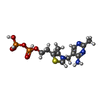 ChemComp-TPP: |
-実験情報
-構造解析
| 手法 | クライオ電子顕微鏡法 |
|---|---|
 解析 解析 | 単粒子再構成法 |
| 試料の集合状態 | particle |
- 試料調製
試料調製
| 濃度 | 0.9 mg/mL |
|---|---|
| 緩衝液 | pH: 7.5 |
| 凍結 | 凍結剤: ETHANE |
- 電子顕微鏡法
電子顕微鏡法
| 顕微鏡 | FEI TITAN KRIOS |
|---|---|
| 撮影 | フィルム・検出器のモデル: TFS FALCON 4i (4k x 4k) 平均電子線量: 44.47 e/Å2 |
| 電子線 | 加速電圧: 300 kV / 電子線源:  FIELD EMISSION GUN FIELD EMISSION GUN |
| 電子光学系 | 照射モード: FLOOD BEAM / 撮影モード: BRIGHT FIELD / 最大 デフォーカス(公称値): 2.4 µm / 最小 デフォーカス(公称値): 0.8 µm |
| 実験機器 |  モデル: Titan Krios / 画像提供: FEI Company |
 ムービー
ムービー コントローラー
コントローラー



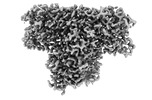

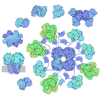
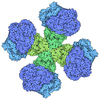
 Z (Sec.)
Z (Sec.) Y (Row.)
Y (Row.) X (Col.)
X (Col.)



























